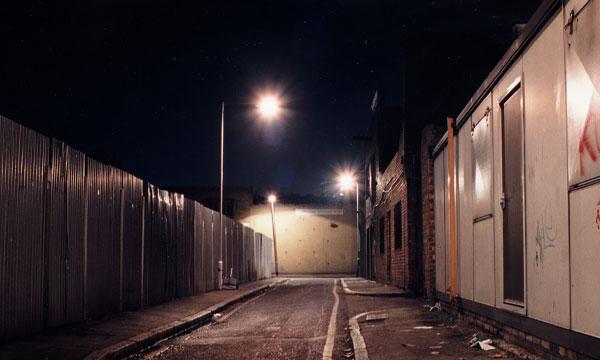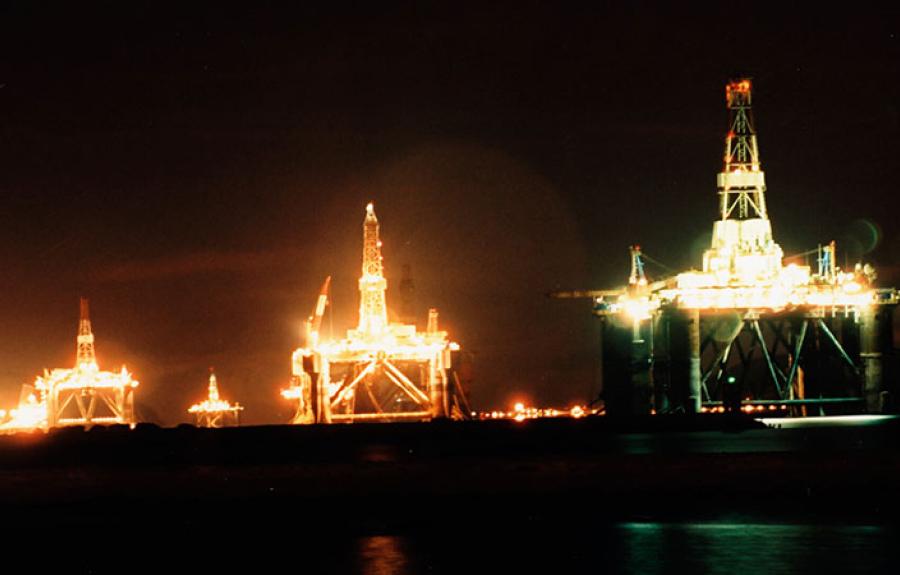Place and Time: The Landscape Films of Emily Richardson

British filmmaker Emily Richardson’s films explore landscapes and environments to reveal the way that activity, movement and light is inscribed in place. The consistent use of the time-lapse technique deconstructs spatial and temporal relations, and works as a passage—from the past to the future—to discover how the impact of time transforms and develops different sites, urban spaces, and architectures, including empty East End streets, forests, North Sea oil fields, post-war tower blocks and Cold War military facilities.
Cobra Mist (2008, 16 mm anamorphic, color, sound, 6'53)
Cobra Mist explores the relationship between the landscape of Orford Ness and the traces of its military history, particularly the experiments in radar and the extraordinary architecture of the Atomic Weapons Research Establishment. Much of what took place there is still under the official secrets act so will only be revealed over time. The buildings have been left to the elements to deteriorate, creating a tension between the time it will take for their secrets to come out and for the buildings to disappear. The place has a sinister atmosphere, which the architecture itself begins to reveal or hint at. The film records the physical traces of its often secretive past using the photographic nature of 16mm film and time lapse to construct an impossible experience of the landscape and expose its history to the camera.
Redshift (2001, 16 mm, color, sound, 3'53)
In astronomical terminology redshift is a term used in calculating the distance of stars from the earth, hence determining their age. Redshift attempts to show the huge geometry of the night sky and give an altered perspective of the landscape, using long exposures, fixed camera positions, long shots and time-lapse animation techniques to reveal aspects of the night that are invisible to the naked eye. The film has a gentle intensity to it, and is composed of changes of light across the sea, sky and mountains. It shows movement where there is apparent stillness, whether in the formation of weather patterns, movement of stars, the illumination of a building by passing car headlights or boats darting back and forth across the sea’s horizon.
Nocturne (2002, 16 mm, color, sound, 4'59)
Nocturne is shot entirely at night in deserted streets around the east end of London and Docklands. The images reveal the presence of the past, or the presence of the dead, hinting at its concealed history. Nocturne is composed of long static viewpoints on 16mm film, using long exposures and time-lapse techniques together give the film an intensity of colour and a sense of fleeting or historical time. The drab, deserted streets are transformed as they appear in hyper-real colour, devoid of traffic and human activity. The film has a neurotic, electric quality as the only signs of life are lights turning on and off in buildings, the occasional ghost image of passing cars and the pulse of overhead trains. On these forgotten streets the sounds of night puncture the silence with more frantic, desperate outbursts and the silence becomes an active element.
Aspect (2004, 16 mm, color, sound, 8'46)
Aspect is filmed in a forest over the period of a year. Using photographic techniques, such as time-lapse and long exposures on single film frames, the forest year is condensed into a few minutes. Light, colour and shadow travel across its surface and the film shifts between seeing the trees as trees and seeing the movement of light and shadow abstracting the real environment. Fragments of unconscious forest sounds, ants in their anthill, the wind across the forest floor, the crack of a twig are reconfigured into an audio piece by Benedict Drew, that articulates the film (and the forest) in an illusive and ambiguous way.
Block (2005, 16 mm, color, sound, 12'43)
Day through night Block is a portrait of a 1960’s London tower block, its interior and exterior spaces explored and revealed, patterns of activity building a rhythm and viewing experience not dissimilar from the daily observations of the security guard sat watching the flickering screens with their fixed viewpoints and missing pieces of action. Eschewing “documentary” interviews with residents for a night-and-day time-lapse tableau of the building’s formidable architecture, it is a powerfully modulated and intensely rhythmic piece.
Petrolia (2005, 16 mm to file, color, sound, 20'59)
Petrolia takes its name from a redundant oil drilling platform sat in the Cromarty Firth, Scotland. The film looks at the architecture of the oil industry along the Scottish coastline where oil and gas supplies are predicted to run dry in the next forty years. Shooting on 16mm film, using time-lapse and long exposure techniques, the film presents a record of industrial phenomena—the toxic beauty of the refinery at Grangemouth, huge drilling platforms gliding across the water as they come in for maintenance and repair at Nigg and the last dance of the shipbuilding cranes in Glasgow harbour.
Spender House (2018, hd, color, sound, 15'00)
The Spender House in Essex was designed in 1968 by Richard and Su Rogers (Team 4) for photographer and artist Humphrey Spender. It was a prototype and precursor to the iconic house, Parkside, designed for Rogers’ parents the following year, making it the first example of hi-tech domestic architecture in the UK. Spender died in 2005 but his spirit is still very present in the house and studio. The film explores the unique architectural qualities of the house and studio and provides a glimpse of its former inhabitant’s life and work as a painter, textile designer and photographer of British life in the 1930s for Mass Observation. Spender House is a temporal exploration of place, an exploded portrait of architecture and inhabitant aided by the use of archival sound recording of interviews made with Spender for the British Library. Connections are made between the place and the person, the place and the archive. There are many rich narratives contained here. To represent the architecture, its interior, the studio and its contents, its position in the landscape and its inhabitants demonstrates the significance of the place.
more info at this website: lux.org.uk/artist/emily-richardson
Ithaca Premiere

